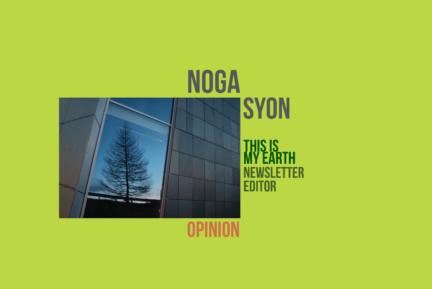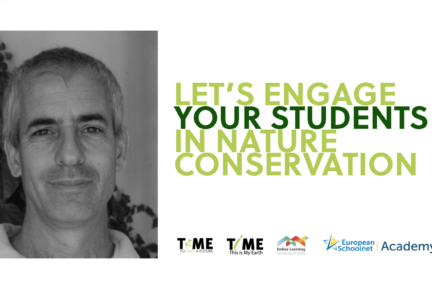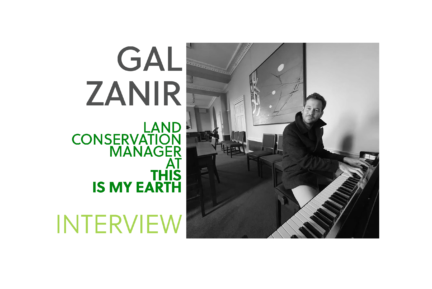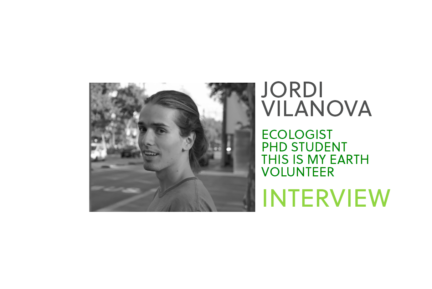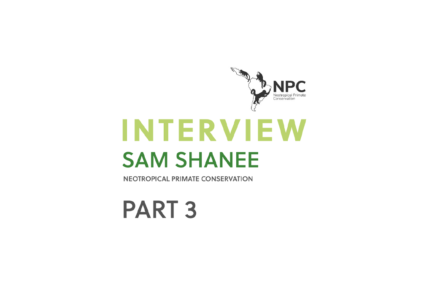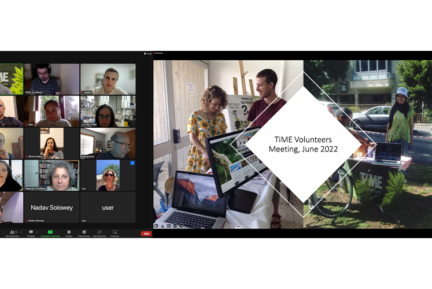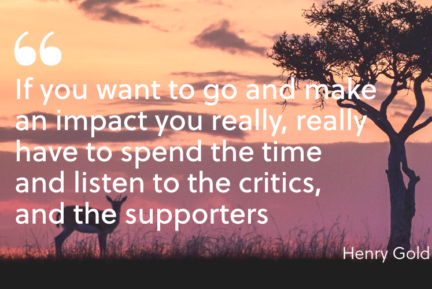We had the privilege to hold an interview with Amanda Sturgeon, CEO of Built by Nature and contributing author to All We Can Save (allwecansave.earth), with her, we’ve discussed architecture, sustainability solutions and This is My Earth‘s contribution to nature conservation.
How do you define yourself?
I’m CEO of Built by Nature. I’m an architect, nonprofit leader, and also consultant. And I’m an advocate to connect people with the environment. I believe architecture is a way to solve our challenges, both climate change and biodiversity collapse; by realizing that we are part of nature and not separate from it, we will be able to see that what we do to nature, what we do to ecosystems, we are doing to ourselves—those realities are not outside of ourselves. I have been using architecture as a tool to raise awareness and facilitate change.
Why is that?
We all live in buildings, and we all spend a lot of time in buildings, so I believe buildings have the power to shape cultures and societies and influence how to interact with the world. I think architecture is a potent sector because it influences how we behave all day and how we relate to each other. [Buildings] are also, sadly, tools that are playing an essential role in how we are destroying the planet.
You often present some of the architecture of indigenous cultures as examples of the way to have a more equal and balanced relationship with nature. Historically speaking, when do you think the gap between nature and human architecture started to become more prominent?
I think we can blame the industrial revolution for accelerating a process that was already taking place. I think at that point in time humans thought they could overpower nature. Understanding aboriginal architecture means sometimes understanding that buildings don’t always need cooling or heating in the ways we think we need them. We now have an incredible global market not only in building materials but also in the energy we need to make our buildings work the way we think they should, which means using incredible amounts of gas and electricity, often produced by burning fossil fuels. People often rely too much on technology. We think by bringing these new solutions to the table, we will be in a better place, but in truth, in the most recent 50 years, we’ve started to unravel.
Would you say architecture is about investment?
Construction is a vast market that relies on investment and private ownership. The real estate market is one of the most significant sectors in the world. By considering buildings another asset of capitalism, we are also increasing the gap between us and nature.
Since 2013 you have been a member of the American Institute of Architects; was that when you discovered your passion for environmentalism, or was architecture a tool to achieve your goals?
I actually came to think about the environment and what we were doing to it thanks to traveling and before I went into architecture. I’ve traveled around the world; I went through Australia, America, and Southeast Asia. Thanks to seeing all those places, I’ve become very intrigued about how architecture was a helpful tool for adapting to the climate and environment, for example, the temples in Southeast Asia. They are adapted to the environment. When I decided to study architecture at the University of Sydney, I had already seen many of these ideas and constructions, and I wanted to explore the impacts on the environment of the current way of constructing buildings. I think I also like to spend time outside, so I tend to like buildings that help me connect to the outside world. When I went into architecture, that was what I wanted to achieve: I tried to reconnect with nature. And it was not easy because there was not really a sustainable-architecture movement at that point; there was so-called environmentally friendly design, which was not a very developed field.
What about nowadays?
I think architecture nowadays acknowledges sustainability, but generally, architects have an independent consultancy that will help them with the decision-making or the validation of their projects, so it is not yet totally integrated into the architect’s vision.
How about the architect community? Have you seen a real change throughout the years?
I think so. In the 90s, we were going out from this kind of postmodernism style. I believe, in architecture school, you are always looking to work and create with the latest style. I think architecture has a long way to go; even the “greenest firms” are mainly still doing sort of the same projects they usually do but adding some sort of “green” or “environmentally friendly” feature. On the other hand, I think there are many genuinely regenerative projects. Many architects also get confused because there’s a lot of greenwashing out there. There’s a lot of misleading information regarding the raw materials needed for construction and which ones are better… So I think lots of young architects are more focused on design. I think we are stuck at this stage in which there is a right way of thinking and a proper way of doing things, and somehow that sort of blocks creative minds from finding better solutions and other solutions.
When did you decide to found Built by Nature?
Our mission is to add building knowledge and create a network; we do not want to replace building materials with timber but to use timber construction as a way to reforest and generate more community-oriented economies. In many cases, deforestation is caused by timber actually not having a value, so timber is replaced by palm oil trees or cleared. In some cases, like in Europe, it is burned, and it is not used for building materials in the way that it could be, and neither in a way which can create a circle for a truly regenerative product. There’s a lot of skepticism about that because, depending on the country, sustainable forestry does not always have a great reputation. If we keep on building on concrete, such as we are doing right now in Sydney, this will cause fatal damage to the world’s climate. Sydney is expected to grow by eight million people within the next few years, and if it continues to build its growth just as has been happening until now, that is expected to cost a massive amount of the world’s carbon budget—and this is only one city in the world! We simply can’t keep on building in the same way and meet our carbon-emission targets. So we are looking at several solutions, and we are focused on finding solutions to this significant issue.
How is Built by Nature being perceived worldwide?
Built by Nature is based in Amsterdam, and we are focusing on Europe. I would say we are becoming more influential. I would say, especially in Europe, there are definitely some policies emerging, especially regarding timber materials and how we reuse them. Many factories are interested in reusing it, as it is a powerful tool. One of the main challenges we are seeing is that the global market of construction materials sometimes doesn’t make a lot of sense. For example, in Australia, we rely a lot on timber material from Austria in Europe. We are looking for more localized solutions which have less impact.
As one of the visible faces of the global women’s leadership movement, why do you think this movement can be helpful when facing the challenges of the climate crisis?
Well… frankly, the men have been in charge and made a bit of a mess. I think it would help to have more women empowered and to make decisions worldwide by taking into account a more feminist/feminine approach. I would say this approach is much more about embracing this connection with nature, not so much dominating it, not feeling that it is something that we have to conquer. I think there are so great women leading great changes, both from an economic perspective, like Kate Raworth, and from the design and architecture perspective. I think there are great female leaders out there. I think it’s time for a different way of thinking because what we’ve been doing isn’t working. We are in a critical climate crisis and about to be in a biodiversity collapse. Soon we might be seeing a food security crisis, as well as we already see with energy security. We are also facing extreme weather events, and all of that is a direct consequence of this way of “use and throw away,” and this “haste makes waste” way of consuming. I also think there are a lot of egos involved in the current crisis, this constant need for personal recognition and validation instead of finding solutions that can have a real impact on the whole community.
Would you say female leadership is more connected to a community approach?
I would certainly say so. Australian aboriginals would say, “connected to country, connected to nature.” I think the main professional battles I had to fight were those in which the community approach and the ego were confronted. I have to say that I have also worked with great men that shared the same community and collaborative approach. I was in Milan a few weeks ago in a workshop that, in theory, was aiming to find new design sustainable solutions, and there was not a single woman in the workshop; I was the only one. I think I have less and less patience for a lot of egos to be in the room. I think it’s time for a change.
Is All We Can Save a step in this direction?
Yes, it is. They asked me to collaborate on this book that women have entirely written. They told me they needed a chapter on architecture and new ways of building, and I was very eager to participate. I think mine is the only essay specifically focused on architecture. The book is fantastic; it gives this very different perspective from women leaders from around the world, from all disciplines; I believe it is a very inspirational collection of essays.
Can you give us an example of a great building that you love?
I would say Sagrada Família in Barcelona is one of my favorite buildings. I have visited it several times. Gaudí really studied how nature works, how muscles work in people, how the trees move, and all these natural principles, and he shaped his architecture around that. That is pretty unusual. In terms of current architecture, I was involved in a project in Seattle and we’ve tried to connect our building with nature from that place. There are not so many buildings in the world that put connection with nature as the cornerstone of their building.

In your essay in the book, you mention that buildings in the future will be more open, more connected to nature, and with less need for artificial ventilation, cooling, or heating… in a sense, This is My Earth aims to be this open and friendly nonprofit that protects nature everywhere and in which everybody is invited. How can we apply these more open ideas with a more assertive community approach to organizations and enterprises?
That’s an excellent question because what has to happen is not only a change in the buildings but also a profound change in how we perceive ourselves in this world. Without that change in our mindset, it would be challenging for us, architects, to change our buildings. We should engage with the regenerative principles and apply them to as many aspects of our life as possible. For example, I have seen things like “shared leadership” work very well in some fields, and I have also seen “regenerative economics” pointing out valuable ideas on coping with the ongoing crisis. Honestly, I’m not sure we will get there until the whole system collapses. Once the investors realize that what they’ve been doing is no longer possible, they will stop.
How can small organizations survive in the current system?
Indeed, your model sounds very promising, and I’m sure there’s a lot to learn from This is My Earth. I want to do something like this in Australia. Actually, we cannot lose any more biodiversity here. We should let people understand the actual cost of their choices because nobody is paying for the disaster that has been caused.
There’s hope?
There’s always hope.

Amanda Sturgeon, CEO of Built by Nature and contributing author to All We Can Save











